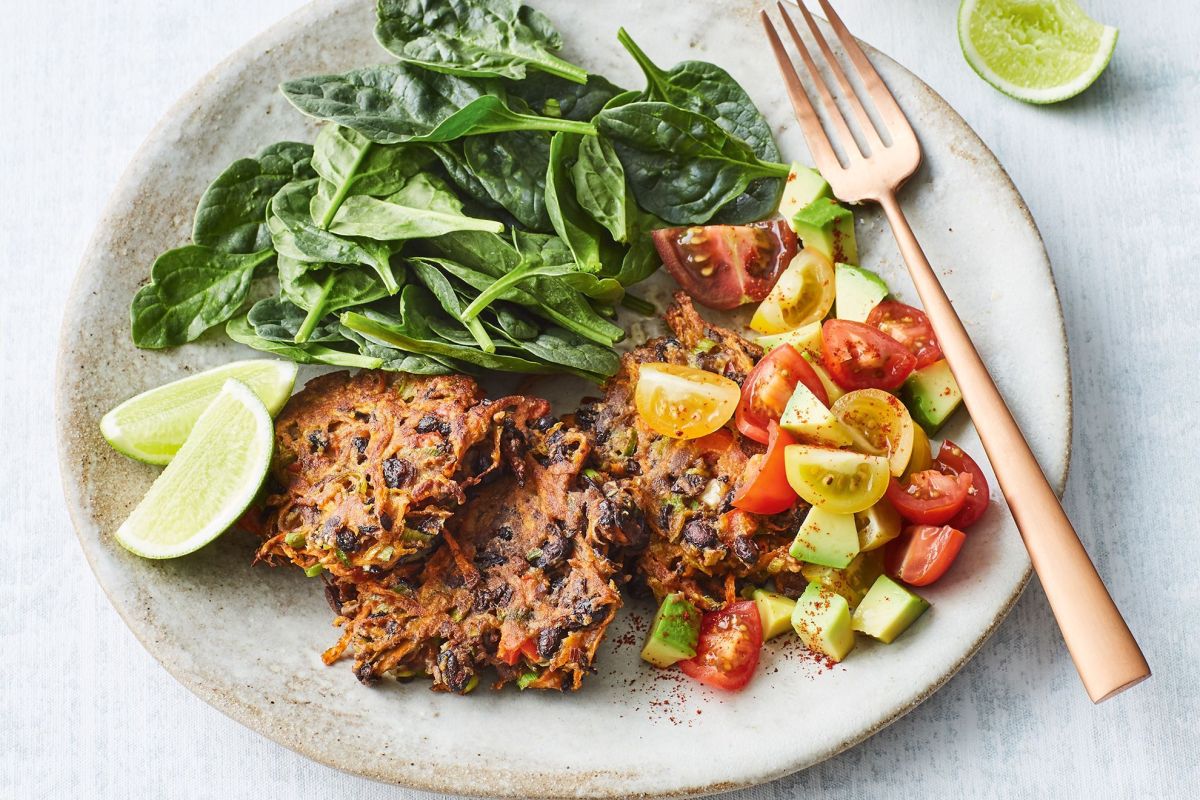Imagine a weeknight where dinner is on the table in under ten minutes, bursting with flavor and satisfying your cravings without sacrificing healthy eating. This isn’t a fantasy; it’s the reality offered by flexitarian 10-minute meals. These recipes embrace the versatility of incorporating both plant-based and meat options, offering a delicious and adaptable approach to busy weeknight cooking. Picture vibrant colors, tantalizing aromas, and the simple satisfaction of a quick, nutritious, and flavorful meal, ready just when you need it most.
This guide dives into five simple yet scrumptious recipes designed to conquer the weeknight dinner rush. We’ll explore efficient grocery shopping and smart storage strategies to minimize prep time. Learn how to adapt these recipes to various dietary needs, master quick cooking techniques, and cleverly utilize leftovers, transforming your weeknight cooking experience from a chore into a joyful culinary adventure.
Ingredient Sourcing & Storage
Efficiently managing your ingredients is key to whipping up delicious and healthy flexitarian meals without spending hours in the kitchen. Strategic shopping and smart storage are your secret weapons for conquering busy weeknights. By focusing on readily available ingredients and implementing simple organization techniques, you can significantly reduce meal prep time and minimize food waste.
Smart ingredient sourcing and storage are fundamental to creating quick and easy flexitarian meals. These strategies streamline your cooking process, ensuring you always have the right ingredients on hand, ready to be transformed into satisfying dinners.
Efficient Grocery Shopping Strategies
Planning your meals ahead of time is the cornerstone of efficient grocery shopping. Create a weekly menu featuring recipes that utilize overlapping ingredients. For example, if you’re making a lentil soup one night, consider using leftover lentils in a salad the next. This reduces the number of unique ingredients you need to purchase and minimizes trips to the store. Stick to a shopping list, avoiding impulse buys. Prioritize purchasing staples such as canned beans, frozen vegetables, and pantry staples (grains, spices) in bulk to save money and time. Consider shopping at stores with pre-chopped vegetable sections to further expedite meal prep. A well-organized shopping list, coupled with a planned menu, significantly reduces the time spent navigating grocery aisles.
Smart Storage Techniques for Maximizing Shelf Life
Proper storage is crucial for extending the life of your ingredients. Refrigerate perishable items promptly after purchase. Utilize airtight containers to prevent spoilage and maintain freshness. For herbs, store them in a glass of water, similar to how you would a bouquet of flowers, or wrap them in damp paper towels and seal them in a plastic bag. Freeze items like fruits, vegetables, and even pre-portioned meal components to extend their usability for weeks or even months. Label and date all containers to easily track their freshness. Employ the FIFO (First In, First Out) method: place older items in front of newer ones to ensure you use them before they expire. This simple strategy helps reduce food waste and saves money in the long run. Visualize your refrigerator as a well-organized pantry, with clearly labeled and dated containers.
Advance Preparation Techniques
Preparing ingredients in advance is a game-changer for busy weeknights. On a weekend or during a less hectic time, chop vegetables like onions, peppers, and carrots. Store them in airtight containers in the refrigerator. Pre-cook grains like quinoa or rice, keeping them refrigerated for quick additions to meals throughout the week. Marinate proteins ahead of time to enhance flavor and reduce cooking time. Batch cooking components, such as a large batch of roasted vegetables, allows for flexible meal combinations. Consider prepping several meals at once on the weekend, portioning them into individual containers for quick reheating during the week. These strategies significantly reduce cooking time on busy weeknights, leaving you more time for relaxation.
Adapting Recipes to Dietary Needs

These 10-minute flexitarian meals are designed for adaptability, allowing you to easily customize them to suit various dietary needs and preferences. Whether you’re vegetarian, vegan, gluten-free, or have specific allergies, simple substitutions and adjustments can transform these recipes into delicious and healthy meals tailored to your requirements. This section will guide you through making these modifications with ease.
Many dietary restrictions can be accommodated by mindful ingredient swaps. Understanding the role of each ingredient in a recipe is key to successful substitution. For instance, a protein source can often be swapped for another, a thickening agent can be replaced with a suitable alternative, and flavor profiles can be adjusted to compensate for omitted ingredients. The key is to maintain the balance of flavors and textures while adhering to your dietary needs.
Vegetarian and Vegan Adaptations
Vegetarian and vegan modifications often involve replacing meat-based proteins. Many of these recipes already feature plant-based protein sources like beans, lentils, or tofu. For recipes that include meat, a simple swap could be substituting chickpeas or lentils for ground beef in a chili recipe, providing a similar texture and hearty feel. Tofu crumbles can effectively mimic the texture of ground meat in many dishes. For binding, consider using flaxseed meal or chia seeds instead of eggs. A vibrant visual representation could be a bowl of hearty lentil stew, richly colored with tomatoes and carrots, alongside a side of fluffy quinoa, showcasing the plentiful protein sources. Remember to adjust seasoning to complement the new protein source.
Gluten-Free Modifications
Gluten-free adaptations focus on removing wheat, barley, and rye. Many of the recipes naturally exclude gluten; however, some might use soy sauce or wheat-based flour as a thickening agent. To make them gluten-free, replace soy sauce with tamari or coconut aminos. For thickening, use gluten-free flour blends (such as almond flour or a blend of rice flour and tapioca starch), cornstarch, or xanthan gum. A visually appealing image could be a plate of vibrant gluten-free stir-fry, featuring colorful vegetables tossed in a glossy, gluten-free sauce, showcasing the texture and appealing visual appeal of gluten-free cooking.
Allergy Considerations and Ingredient Substitutions
Managing food allergies requires careful ingredient selection. Common allergens include nuts, dairy, soy, and eggs. Detailed ingredient lists are crucial; always check labels to ensure products are free from allergens. Substitutions can range from using dairy-free milk alternatives (almond, soy, oat) to replacing nuts with seeds (sunflower seeds, pumpkin seeds) or avoiding soy products altogether. A vivid image would be a table displaying various allergen-free alternatives, neatly organized and clearly labeled, such as almond milk next to dairy milk, or sunflower seeds beside peanuts. This emphasizes the variety of available substitutes.
Adjusting Portion Sizes for Calorie Requirements
Controlling portion sizes is essential for managing calorie intake. Start by measuring ingredients accurately. Reduce portion sizes proportionally; if a recipe serves four, reduce ingredient quantities by half to serve two. Consider adding more vegetables to increase volume without significantly increasing calories. You can also substitute higher-calorie ingredients (like cream) with lower-calorie alternatives (like Greek yogurt). A clear visual representation would be a comparison of two plates: one larger, overflowing with food, and the other smaller, containing a balanced portion of the same meal. This clearly illustrates the difference in portion sizes and the effect on calorie intake.
Step-by-Step Cooking Guides
This section provides a detailed, step-by-step guide for preparing one of our delicious and efficient 10-minute flexitarian meals: One-Pan Lemon Herb Roasted Salmon and Asparagus. This recipe showcases quick cooking techniques and minimal cleanup, perfect for busy weeknights. The vibrant colors and fresh flavors will elevate your dinner routine without sacrificing precious time.
One-Pan Lemon Herb Roasted Salmon and Asparagus
This recipe combines the ease of one-pan cooking with the healthy benefits of salmon and asparagus. The bright lemon and fresh herbs add a burst of flavor, creating a restaurant-quality meal in under 10 minutes. Precise timing and efficient preparation are key to achieving this speed.
Before you begin, ensure your oven is preheated to 400°F (200°C). Prepare all ingredients beforehand to streamline the cooking process. This includes washing and trimming the asparagus, and patting the salmon fillets dry.
- Prepare the Ingredients (1 minute): Wash and trim one pound of asparagus spears. Pat dry two 6-ounce salmon fillets. Zest and juice one lemon. Chop two tablespoons of fresh herbs (dill, parsley, or thyme work well).
- Arrange on Baking Sheet (1 minute): Line a baking sheet with parchment paper for easy cleanup. Arrange the asparagus spears in a single layer on one side of the baking sheet. Place the salmon fillets on the other side.
- Season and Dress (1 minute): Drizzle the salmon and asparagus with one tablespoon of olive oil. Sprinkle with the lemon zest, lemon juice, and chopped herbs. Season generously with salt and pepper.
- Roast (7 minutes): Place the baking sheet in the preheated oven and roast for 7 minutes, or until the salmon is cooked through and the asparagus is tender-crisp. The cooking time may vary slightly depending on your oven and the thickness of the salmon fillets. A meat thermometer inserted into the thickest part of the salmon should register 145°F (63°C).
Remember to adjust cooking time based on your oven and the thickness of your salmon fillets. Overcooked salmon will be dry, while undercooked salmon may be unsafe to eat.
Serve immediately. The bright lemon and herb flavors complement the richness of the salmon beautifully, and the tender-crisp asparagus provides a delightful textural contrast. A simple side of quinoa or brown rice would complete this healthy and satisfying meal.
Meal Prep & Leftover Strategies
Mastering the art of meal prepping and creatively using leftovers is key to maximizing the efficiency and enjoyment of your flexitarian weeknight meals. By strategically preparing components in advance and repurposing leftovers, you’ll not only save valuable time but also reduce food waste and add exciting variety to your weekly menu. This section will guide you through practical strategies to streamline your cooking process and elevate your culinary creativity.
Preparing components of these meals ahead of time dramatically reduces weeknight cooking stress. Imagine the vibrant scene: your refrigerator neatly organized, showcasing pre-chopped vegetables gleaming in airtight containers, flavorful marinades permeating tender proteins, and grains perfectly cooked and ready to be incorporated into a quick and satisfying meal. This proactive approach transforms chaotic weeknights into moments of culinary ease.
Advanced Component Preparation
Prepping components such as chopping vegetables, cooking grains (like quinoa or brown rice), and marinating proteins can significantly shorten cooking time. For example, chop a large batch of onions, peppers, and zucchini on the weekend; store them separately in airtight containers. Similarly, cook a large quantity of quinoa and store it in the refrigerator – it’s a perfect base for many flexitarian dishes. Marinating tofu or chicken overnight intensifies flavors and tenderizes the protein, making it ready to cook quickly on busy weeknights. This organized approach transforms weeknight cooking from a chore into a quick assembly process.
Creative Leftover Transformations
Leftovers are not simply remnants of a past meal; they are hidden treasures waiting to be transformed into exciting new culinary adventures. Consider leftover roasted vegetables: they can become the star of a frittata the next morning, a vibrant addition to a hearty salad, or the flavorful base for a quick soup. Leftover grains can be repurposed into a satisfying breakfast bowl with fruit and nuts, or incorporated into veggie burgers. Imagine the satisfying crunch of leftover roasted sweet potatoes in a vibrant breakfast hash, or the creamy texture of leftover lentils in a hearty lentil soup. The possibilities are endless.
Freezing Portions for Future Use
Freezing portions of your flexitarian meals is an excellent strategy for extending their lifespan and ensuring you always have a quick and healthy meal on hand. Ensure your chosen containers are freezer-safe. Allow the meals to cool completely before freezing to prevent ice crystal formation, which can alter texture. Label each container clearly with the contents and date of freezing. For optimal quality, consume frozen meals within 2-3 months. Consider freezing individual portions in smaller containers for convenient single-serving meals. This forward-thinking approach ensures that a delicious and healthy meal is always within reach. For instance, a hearty lentil stew can be easily frozen in individual portions for a quick and nutritious lunch or dinner on a busy day.
Conquering weeknight dinners doesn’t require hours in the kitchen. With a little planning and these 10-minute flexitarian recipes, you can enjoy delicious, healthy meals that cater to your busy schedule and dietary preferences. From efficient grocery shopping to creative leftover strategies, this guide equips you with the tools to transform weeknight cooking from a stressful event into a quick, satisfying, and even enjoyable experience. Embrace the flexibility, savor the flavors, and reclaim your weeknights!
FAQ Insights
Can I make these meals ahead of time?
Absolutely! Many components, like chopping vegetables or cooking grains, can be prepped on the weekend. This significantly reduces weeknight cooking time.
What if I’m allergic to a specific ingredient?
Each recipe offers substitution suggestions to accommodate common allergies and dietary restrictions. Consult the recipe’s adaptation section for alternatives.
Are these recipes suitable for children?
Yes, most recipes are easily adaptable for children’s palates. You can adjust seasonings and portion sizes to suit their preferences.
How do I store leftovers effectively?
Properly store leftovers in airtight containers in the refrigerator for up to 3-4 days. Freezing portions is also a great option for future meals.


